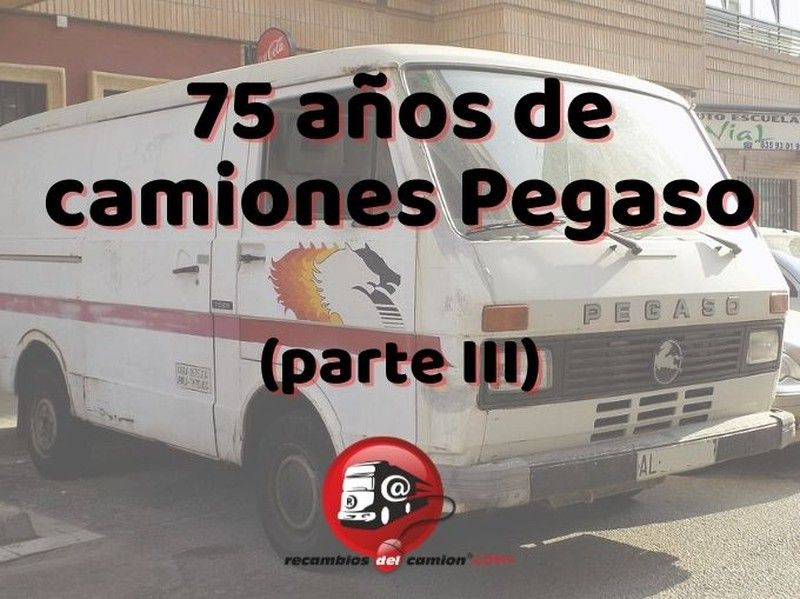75 years of Pegaso trucks (part III)
In this third article we have just reviewed the history of this great Spanish brand, dedicated to the manufacture of trucks, now that it is 75 years old.
You can retrieve the first part of the article HERE and the second part HERE.

During 1975 a great novelty was presented: the tilting cab.
On the other hand, it continues to bet on innovation and its presence in Barcelona with the inauguration of an experimentation center located in the Zona Franca.
But the oil crisis came... A little later than in the rest of the world, since Spain was in full economic boom, but it did come. The entire sector was affected worldwide and the accounts of Pegaso, until now very healthy, began to notice it. Sales fell and the fixed costs of this automotive giant were high.
In 1981 the American company International Harvester took control of the management by buying a large part of Enasa's shares, with the idea of taking advantage of Pegaso's knowledge in the production of heavy vehicles, a sector in which the American company had no experience.
But the crisis caused International Harvester to leave three years later.
The brand continued to produce military models alongside its civilian vehicles. It also achieved very good results in this sector that led the brand to obtain international prestige, selling its military models beyond the Spanish borders. At the end of the 70s, the brand manufactured amphibious trucks and the famous BMR, light armored vehicles with 6 wheels, which were very popular.
The BMR-600 are currently still active in the Spanish Army, although their progressive withdrawal is planned in the coming years, since they have become obsolete, more than 40 years later. They have also been used in the armies of Egypt, Saudi Arabia and Peru.
Precisely one of the most important military contracts of the brand was closed with the Egyptian government, to which 10,500 4x4 trucks of the 3046 model were sold.
Originally the order was for 13,000 units, but due to non-payment, 2,500 units remained undelivered. The brand, in another masterful move, transformed these military models into fire trucks to dispose of this excess production. We can still find some of these in Spanish fire stations.
Due to its relationship with the country of the pharaohs and the pyramids, the Pegasus 3046 was known as the Egyptian Pegasus or as the Gaddafi Pegasus, since some models were also sold to the Libyan government.
In 1983 the brand launched the Pegaso T-1, its new range of trucks with improved engines. These reached powers of 340 CV in the models that incorporated intercooler.
In 1984 the manufacture of buses began, collaborating with the MAN company. A collaboration that will last for many years.
With MAN and Volkswagen, the range of vans manufactured by Sava is completely renewed, resulting in the launch of the Ekus range.
It also joins DAF to develop a new cabin, which in 1987 was incorporated into the Pegaso Troner, in the DAF 956 and in the Stratos of the English brand Seddon-Atkinson, which in this case did not have Pegaso engine but Cummins engines. Seddon-Atkinson was acquired by Pegasus in 1983.
From the union of Enasa with DAF, which made possible the development and production of the Pegaso T-3 Troner, the Cabtec joint venture was born. Although the Troner was introduced in 1987, it was not marketed until 1988. It was produced until 1993.
The Troner is considered Enasa's last truck, since Iveco, from the Fiat group, acquired 60% of Enasa in 1990, absorbing and taking control of the Pegaso brand.
The Italian brand then had an aging range of trucks that had been outdated at European level compared to its competitors and that caused it to enter into a crisis. To save the situation, it was decided to invest in Enasa.
Later, in 1991, IVECO also acquired the English brand Seddon-Atkinson, also owned by Enasa.
After its acquisition came the renewal of the Ekus vans that gave way to the well-known Daily. The Miders, presented in 1989, are also renewed, and the Troners are equipped with 400 hp engines.
In 1992 the new Eurotech range was presented, already under the Iveco brand.
The end of Pegaso as a brand can be established in 1993, when the last of its engines was produced.





Opinions of our clients
Receive our news